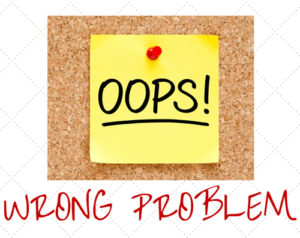28 Jul Hitting Roadblocks? You May Be Solving for the Wrong Problem
 However, as problems become more complex and the stakes get higher, it is much harder to resolve these challenges. And the pressure to move quickly intensifies the situation.
However, as problems become more complex and the stakes get higher, it is much harder to resolve these challenges. And the pressure to move quickly intensifies the situation.
When you need to solve the big problems – the ones that have significant impact on your business – you need a systematic approach that is effective and repeatable.
The good news is there is such a system and it can be used to address challenges of all levels of complexity.
This post addresses step number 1 in the problem solving process – problem identification: First, you must clearly define the problem as well as the desired outcome.
This step may seem obvious, but it is our natural inclination to move as quickly as possible into resolution mode. Action = progress, or so this is how we feel. Yet action in the wrong direction veers us off course and either inadequately solves the problem or doesn’t solve the problem at all.
Therefore, it is well worth the investment to spend time on problem identification, which is broken down into four parts.
- Describe the problem. Say exactly what is on your mind – how you are viewing the problem at the moment. This exercise gets the problem on the table.
- Assess the situation. Step back and objectively evaluate the situation. Gather the necessary information that tells you why you are worried about this challenge now and what you believe is its impact on the business.
- Define desired outcome. Describe what you wish to accomplish and under what conditions. Ask yourself what success looks like – what happens if the problem is resolved?
- Redefine the problem and pose as a question. Ask a question that takes into account the situation and demands an answer that produces your desired outcome. Essentially, “I am here, and I would like to be here – how do I make that happen?”
As an example, I recently had a client who came to me and indicated that he needed help to identify what types of strategic partners his company should pursue. This was how he described the problem.
Once he started talking about the types of partners he was considering the situation became confusing. After speaking with him at length I learned that he wasn’t convinced that he needed to be leveraging partners, but thought he may be missing something important for the business.
I realized that he was trying to solve for the following, “It seems we should be pursuing partners, but which ones?”
But, before he could even begin to consider which partners to pursue, it was necessary to determine if he should be pursuing partners at all. And a critical factor to take into consideration was that he did not have the resources to pursue partners that may or may not have a material impact on the business. This was his situation.
In speaking further, we determined that what he really wished to accomplish, his desired outcome, was to determine if partners could have a material impact on the business.
Thus, the problem to solve was “Can third parties support the strategic goals of the business, and if so, how?”
From here we were able to generate a plan to answer this question and make an informed decision.
In the above example, as is often the case in dealing with complex problems, uncertainty about the situation led to ambiguity about what really needed to be resolved.
Problem identification removes ambiguity and provides a clear understanding of the problem as well as a definition of success. Armed with this information you can move to the next steps in the process to identify and implement a solution.
This is the first of a series of posts in which I will describe the various steps involved in solving complex problems, including problems much more complex than the example above, as well as tips to master the process.

